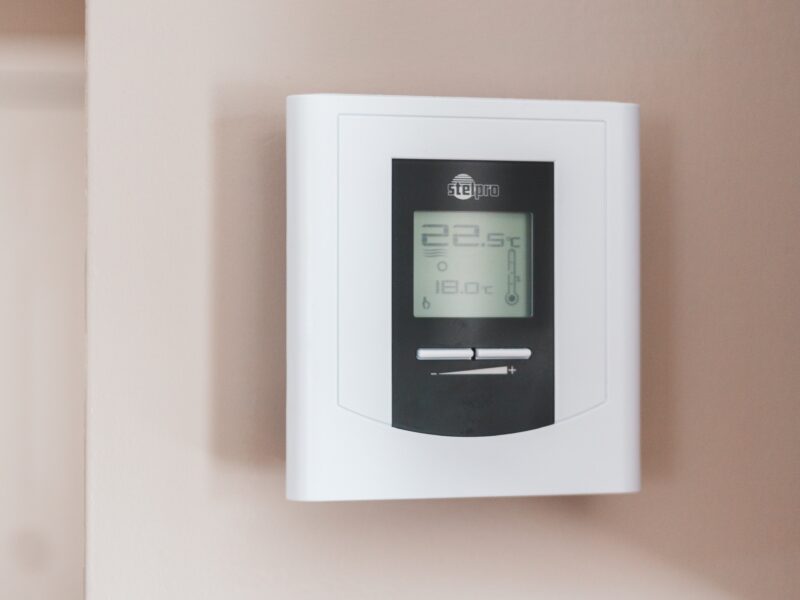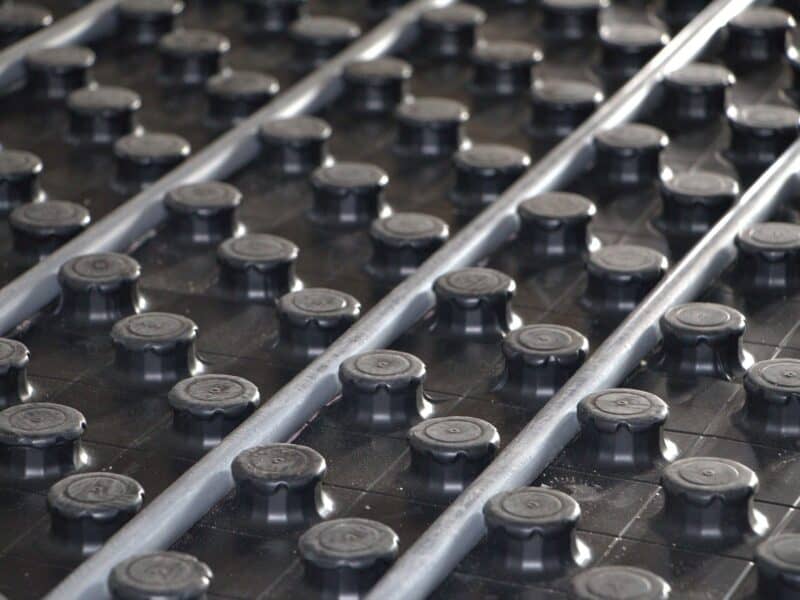In many cases, especially through the long, dark winter months, it is impossible to achieve true comfort without first achieving warmth.
In fact, being warm is often something that is taken for granted – however, even with the best insulation installed, temperatures may be so low as to need help in the form of additional heating.
Obviously, there are several ways to heat your home but by far, the most comfortable is by radiant heat. This is heat that emanates from a hot source, similar to the gentle warmth of the sun.
By projecting this radiant heat through the floor, you can produce a perfect warmth which surrounds you and creates the ultimately comfortable atmosphere.
The Romans first developed underfloor heating over 2,000 years ago by using a furnace to heat the air in underground spaces, such as cellars. This air would then circulate and travel up channels in the walls to warm the rooms above.
Why is Underfloor Heating so Special?
Conventional heating systems work by heating the air next to them (e.g. radiators) and relying on the air convection to transfer the heat around the room.
This tends to produce a situation where hot air rises to the ceiling, either escaping through the roof, or cooling and returning back down to ground level.
This leads to a vicious circle where your head is overheated, leading to stuffiness, and your feet remain cold.
As warm feet are the body’s natural thermostat for comfort, increased heating to achieve warm feet simply means more discomfort for an already over-heated head.
Underfloor heating works differently by generating 50% of its warmth via low-temperature radiant heat which does not rely on air convection.
It is simply released evenly and absorbed by the people and objects in the room. It also reverses the temperature profile by gently heating the room from bottom up, so that the ground level is warmest.
This creates the ideal situation where there the body feels comfortable with warm feet and cool head. It also means that heat loss is reduced from people’s bodies without overheating the ambient air.

Electric Underfloor Heating
Electric Underfloor Heating is the way underflooring heating was first developed, using electric resistance cables laid into thick concrete subfloors which were then heated during the night using cheaper electricity. However, there were some problems due to poor temperature control and floors were often too hot in the morning.
Modern versions are more sophisticated. They can come either as a loose wire system with a dual-core heating element which can be installed without digging up the floor or embedding anything in concrete.
In fact, the system is simply fixed to the subfloor and the chosen flooring material (e.g. tile) laid back over it.
Alternatively, you can use matting system where the electrical heating element is attached to a tough fibreglass mesh which is then rolled out to cover the subfloor, before installing the final flooring material.
Both methods have been shown to be economical and environmentally-friendly.
Easier Installation
Because most of the electrical underfloor heating elements can be put down on a concrete or wood sub floor, with just thermally insulating matting between them, there’s no need to dig up floors or floorboards to lay the heating down.
This is in contrast to Water Based Underfloor Heating where the pipes need to be buried a couple of inches below a concrete screed, making them very difficult and expensive to fit in houses. Water based underfloor heating is much more suited to new builds or complete renovations.
Running Costs
In terms of running costs electrical solar underfloor heating is likely to be more expensive to run than water based. However this could change as energy prices fluctuate, and if you could power the underfloor heating from photo-voltaic solar panels charging a set of batteries then you would have no running costs anyway.
As mentioned above installation is relatively easy. After laying the heating element down on the thermal insulating layer, underlay and flooring are put on top.
The flooring can be almost anything, including Carpet, but it is important to make sure that both the underlay and the carpet, tiles, Laminate, vinyl or whatever you choose are marked as suitable for electric underfloor heating.
Different Electric Element Formats
There are many different types of electric element on the market and there is not yet any one leading type or manufacturer. Some are in the form of mats with electric elements interspersed with supporting elements of fibre or plastic. Others are flat ribbons of multi-core cable set in a supporting plastic grid. There does not seem to be any particular advantage to any one type so far.
Another advantage of electric underfloor heating is that it can be installed in one room or many rooms. It is difficult and expensive to put a water based underfloor heating system in for just one room. The electrical connections can be made by a qualified electrician so there isn’t even a need for specialist installers for electric underfloor heating.
Final Consideration
There’s only one other disadvantage with electric underfloor heating: there can be problems with the heating elements if certain items are left on the floor for a long time. The problem is with items that do not allow heat to pass through easily such as piles of books, very heavy rugs, piles of clothes or bedding and very soft furniture like bean bags.
While this is something that can easily be worked around for most people, it certainly puts teenagers’ bedrooms off limits for electric underfloor heating.

Warm Water Underfloor Heating
A newer method of underfloor heating is to use Warm Water circulated from the boiler through continuous lengths of pipe embedded under the floors.
This uses a similar heating process as radiators and is electrically operated so as to provide room-by-room temperature control. It is particularly useful for specific zones and extensions, such as conservatories, which may need to be heated at different times to the rest of the house and may suffer from extensive heat loss.
It is claimed that warm water systems are more economical than electric underfloor heating.
What about Efficiency?
One of the reasons people have shied away from underfloor heating in the past is worries about efficiency and the system’s energy-saving abilities.
Some studies have been done and the results show that energy consumption by underfloor heaters range from 10% more than conventional heating systems to about 50% less than conventional heating systems.
This variation is due to the type of insulation in place, the usage patterns of the occupants and the personal preferences for ambient temperature.
Generally, radiant heating systems are considered very efficient as it creates an atmosphere with a lower ambient temperature due to less heat loss from your body.
However, if you insist on achieving the same ambient temperature as with conventional heating, you could end up overheating the room and thus losing out on energy savings.
Underfloor Heating Benefits .…
The even spread of heat means that there are fewer convection currents around the rooms, the floor is pleasantly warm underfoot and the lower temperatures make it more economical to run.
These lower temperatures also mean that underfloor heating will complement the temperature output levels of ecologically friendly energy sources such as solar water panels and ground source and air source heat pumps.
Interior designers like Underfloor Heating because there are no radiators on the walls to get in the way of decoration or furniture.
In addition, there is very little impact on heating costs of having high ceilings, because the heat rises from the floor, so it gives architects freedom to design with more expansive spaces.
…. and the Disadvantages
It’s not all roses though. Although the water doesn’t have to be heated to such a high temperature (45 to 55 degrees as opposed to the 90 to 95 degrees of radiators) there is a lot more water to heat up.
The pipes that carry the warm water are run back and forth across the floor of every room to ensure good coverage so the amount of water in the system is usually two to three times the volume of a central heating radiator network.
It’s also takes longer to change the temperature with underfloor heating as the thermal mass is large and the heat output low.
The idea is to keep the heating on permanently except in the summer and only lower the temperature a little, say three degrees, if you are going out for the day or overnight. Both these aspects can mean lower running costs than expected.
Cost and Effort of Installation
Water based underfloor heating is also undeniably more expensive and difficult to put in than a traditional radiator based system. Firstly you need to lift all the floors (if you’re adding it to an existing house), lay the coils and then replace the floors, all of which entails a major labour cost.
Secondly, all the pipework in each room needs to have two connections to a central point where a manifold collects and distributes warm water out and cold water in.
With a radiator based system there only needs to be one or two rings run around the house and the pipes can be attached to the wall, they don’t necessarily have to be installed under the floor.
However if you are in the process of building or completely renovating a house, the extra expense of installing water based underfloor heating over a traditional system will not be as great. It is hard to add water based underfloor heating to a traditional system, for an extension or conservatory for example.
Suitable Flooring for Underfloor Heating
Water based underfloor heating will work with most solid flooring materials although you do have to take care with real wood floors. The issue here is the speed at which the timbers are heated up, so as long as you take care with that initial startup it should be ok.
Refer to the manufacturer’s instructions if you have them, but Timber Floorboards in an old house ought to be ok as they will be very dry. If there is more than 10% moisture in the wood then you may get warping and other problems.
Ceramic tiles and stone floors perform very well and you can add rugs where you want a softer feel underfoot. Carpet is possible, but take care with the type of carpet and underlay as well as any adhesives used, referring to the manufacturers if in doubt.
You won’t regret installing water-based underfloor heating. However, there’s no doubt that if you can face the initial investment of installing underfloor heating it will definitely make your life more comfortable and luxurious.
Finally…
If all the occupants are out at work during the day but then have a different routine at weekends, a good thing to install would be a thermostat connected to your underfloor heating system so that you can programme a schedule to suit your lifestyle.


